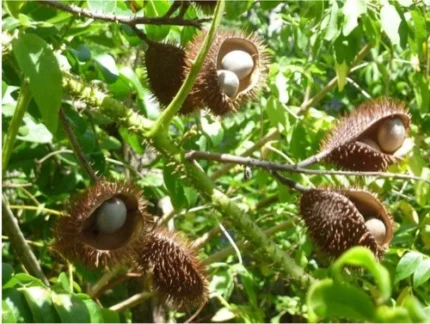We do not come across the descriptions of tirigicca in brhat trayi. Among the nighantus tirigandha / tirigicccha is quoted by kaiyadeva after madanapala. Basing on one of the synonym karanji, it needs to be identified with cirabilva (H. integrifolia). But cirabilva is already quoted among karanjadvaya. Cirabilva is otherwise called as putika or putikaranja. Bhavamishra quoted ciribilva as the synonym of karanja but he did not use the same synonym for karanji. Similarly ghritakaranja is described with the synonym pµutika but not with kantakakaraja. Thakur Balvant Singhji was of the opinion that Toddalia asiatica Lam which is known as kancana or kanja in the vernacular language appears to share some of the properties of kantakaranja. Author is of the opinion that this might be tirigiccha of madanapala nighantu.
Botanical Description – This woody liana can reach a height of 10m in forests as it uses other trees for support. The corky stems are covered with knobby thorns and are yellow when cut. The attractive shiny trifoliate leaves are light to dark green and are extremely aromatic, smelling of lemon when crushed. The twigs are covered in small, recurved thorns. The small, greenish-yellow flowers appear in spring and the plant continues flowering until the beginning of autumn. The berry-like fruits are borne right through summer. The fruit, 5-7mm in diameter, are orange in colour when ripe and taste like the skin of an orange.
Major Chemical Constituents – Alkaloid (l,3)benzodioxolo(5,6-c)phenanthridine, 12,13-dihydro-2,3-dimethoxy-12-methyl-(dihydronitidine).
Research – In vitro cytotoxicity screening indicated the presence of a highly selective cytotoxic compound in the extract of Toddalia asiatica Lam. The known alkaloid (l,3)benzodioxolo(5,6-c)phenanthridine, 12,13-dihydro-2,3-dimethoxy-12-methyl-(dihydronitidine) was identified as an active material from this plant. This alkaloid had highly specific cytotoxicity to human lung adenocarcinoma (A549) cells. Results: The results of the fluorescence activated cell sorter (FACS) analysis and the measurement of caspase-3 activity showed that dihydronitidine induced specific apoptotic cell death in A549 cells. Gene expression analysis in the apoptotic cells found that dihydronitidine variously regulated the cell cycle related genes (CDK2 and CCNE), and up-regulated the cell death related genes specifically in tumor cells. Thus dihydronitidine manifested its characteristics in the tumor selective cytotoxicity, contrasting with the case of a known anticancer agent camptothecin (CPT). Microscopic observation further revealed the specific accumulation of dihydronitidine within the cytosolic organelle, but not in the nuclei of adenocarcinoma. No accumulation was observed with CPT in all cell lines. The data suggested that dihydronitidine toxicity targeted a particular intracellular organelle in the tumor cells [Hironori et al., 2006].






Reviews
There are no reviews yet.